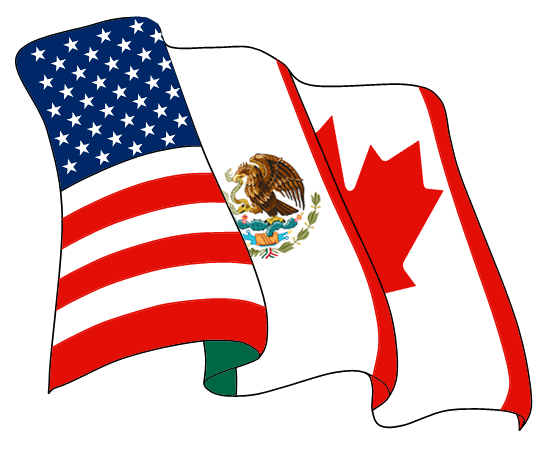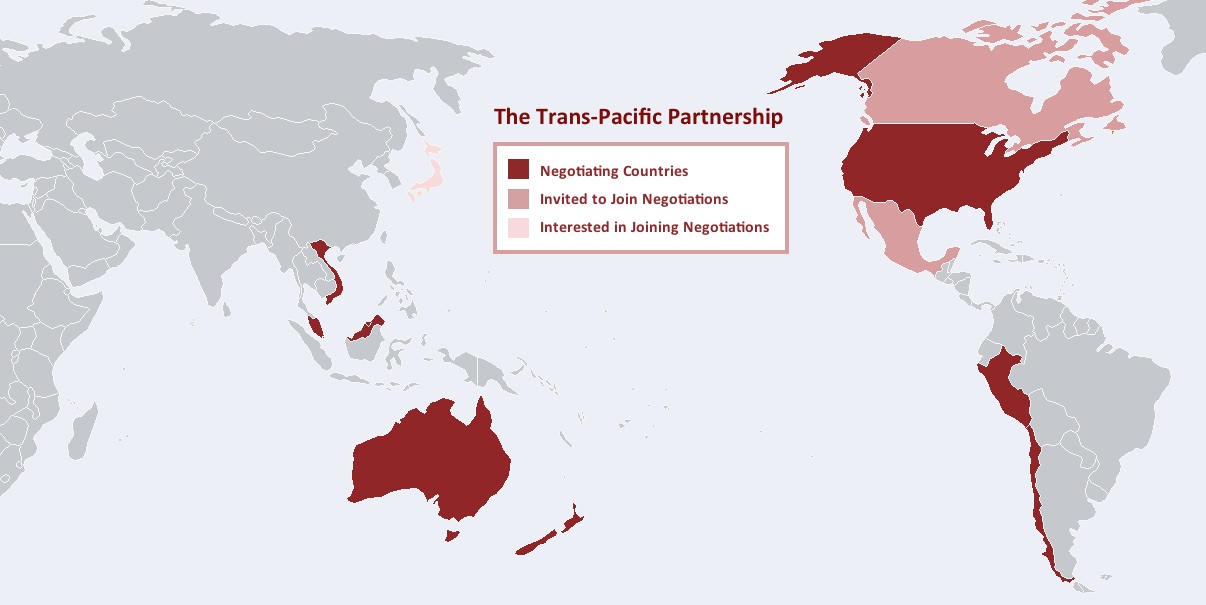Difference Between NAFTA and TPP
NAFTA (North America Free Trade Agreement) and TPP (Trans-Pacific Partnership) are two of the most debated free trade multilateral agreements in the world. Despite discrepancies in their scope, focus and provisions, the most striking difference between the two is the fact that NAFTA entered into force in 1994 while the TPP never came into effect as the United States – under President Trump – withdrew from the agreement before it was ever implemented.
The North American Free Trade Agreement was created to promote free trade between the United States, Mexico and Canada, eliminating most of the tariffs and barriers to trade among the three countries. While the agreement aimed at enhancing economic growth, many (in particular in the U.S.) believe that it is disproportionately favoring Mexico and is not having the desired effect on national economies. For this reason, President Trump initiated several rounds of re-negotiations to modify the agreement and, in particular, lower trade deficit between the United States and Mexico. President Trump expressed his concerns regarding the TPP as well, and signed a memorandum officially withdrawing the United States from it just few months after the elections.

What is NAFTA?
The NAFTA (North America Free Trade Agreement), which came into effect on January 1, 1994, is a bilateral trade agreement between the United States, Mexico and Canada. The treaty followed (and superseded) the Canada-United States Free Trade Agreement that had entered into force in 1989. Mexico was the last of the three countries to enter the agreement, after starting negotiations in 1991. The main goal of the NAFTA was (and is) the elimination of duties and barriers to free trade among the three countries, although its scope is rather comprehensive. NAFTA contains provisions that relate to:
- Rules of origin;
- Customs procedures;
- Investment;
- Protection of intellectual property rights;
- Dispute settlement procedures;
- Sanitary and phytosanitary measures; and
- Government procurement.
The North America Free Trade Agreement was championed by former U.S. President Bill Clinton, who integrated it with two side agreements – the North American Agreement on Labor Cooperation (NAALC) and the North American Agreement on Environmental Cooperation (NAAEC) – in order to protect and preserve the environment and the rights of U.S. workers and to address the concerns of some members of the Senate and the House of Representatives.

What is TPP?
The TPP (Trans-Pacific Partnership) is a trade agreement between Australia, Brunei, Canada, Chile, Japan, Malaysia, Mexico, New Zealand, Peru, Singapore and Vietnam and the United States, which was signed on 4 February 2016 but never entered into force as the United States withdrew shortly after. The TPP included provisions regarding:
- Reduction of barriers to trade (both tariff and non-tariff);
- Creation of an investor-state dispute settlement mechanism (ISDS); and
- Regulation of competition policy; and
- Promotion of free trade among the member countries.
The original TPP never entered into effect as President Donald Trump signed a memorandum to officially withdraw the United States from the agreement. The withdrawal from the agreement was part of Trump’s putting-America-first policy, and the President showed interest in entering “fair, bilateral trade deals” aimed at promoting the U.S. economy and at bringing new jobs into the United States. After the U.S. withdrawal, some of the remaining countries indicated their willingness to continue negotiations, and finally reached an agreement in January 2018, when the TPP became the CPTPP (Comprehensive and Progressive Agreement for Trans-Pacific Partnership).
Similarities between NAFTA and TPP
The two agreements are different in scope and focus, but have nevertheless a number of common features:
- Both aim at promoting free trade by eliminating or significantly reducing tariffs and barriers;
- Both include provisions that deal with customs procedures, rules of origins, dispute settlement, sanitary measures, investments, etc;
- Both agreements include provisions concerning environmental protection and labor rights, although the NAFTA is integrated with the NAALC and NAAEC that deal more extensively with the matters;
- President Trump has strongly opposed both agreements. He has withdrawn the U.S. from the TPP – thus preventing the treaty from entering into effect – and has initiated various rounds of negotiations with Canada and Mexico to change and improve the NAFTA, creating more favorable conditions for the United States; and
- Both agreements have wide geopolitical implications and tend to promote the expansion of multinational corporations rather than improving wage equality and economic growth within the countries concerned. Furthermore, both NAFTA and TPP include provisions that may exempt multinational corporations from being held accountable by national governments; in particular, with the creation of the investor-state dispute settlement mechanism (ISDS) proposed by the TPP, corporations would have been able to sue governments for judicial decisions and law that hinder their profit.
- Indeed, the promotion of free trade involves a certain degree of deregulation and inevitably promotes the capitalist paradigm as all as the expansion and growth of multinational corporations. Had it entered into effect, the TPP would have created an economic bloc incorporating approximately 40% of the global economy. As such, many feared that the creation of such polarized group could have worsened global imbalances and wage inequalities, and could have significantly affected smaller and local businesses.
Difference between NAFTA and TPP
Aside from the fact that the North American Free Trade Agreement entered into force in 1994 and is still in place (although even under revision) while the Trans-Pacific Partnership has never entered into effect, there are other significant differences between the two agreements.
- NAFTA involves the three north American countries: Mexico, Canada and the United States, and was aimed at creating a north American free trade bloc in order to promote regional trade and to eliminate many of the existing barriers hindering imports and exports. Conversely, the TPP involves a much larger number of countries and has (or had) the main goal of strengthening the relationship between the U.S. and some of the main Asian economies. In other words, the TPP was created to strengthen the U.S. role in the Asia-Pacific region, in an attempt to reduce China’s influence on the neighboring countries; and
- Analyzing the consequences and effects of the two agreements may be complicated, especially because the TPP never came into effect. However, looking at NAFTA, we see conflicting opinions on the impact of the treaty on national economies and international alliances. Some say that the elimination of barriers in north America let to a boost in foreign investment (particularly in Mexico) and to a significant growth in domestic GDP, but at the same time others argue that the economic benefit of the NAFTA were not as significant, especially for the United States. The same argument is often been made for the TPP, with several opponents arguing against the profitability of the agreement.
NAFTA vs TPP : Comparison Chart
Although they have similar goals, NAFTA and TPP have specific differences in their texts and provisions, and were created in different historical movements. Therefore, building on the differences explored in the previous section, we can identify few other aspects that differentiate the two treaties.

Summary of NAFTA vs TPP
NAFTA and TPP are two of the largest (and most debated) multilateral agreements incentivizing free trade and advocating for the removal of tariffs and barriers among the signatory countries. NAFTA (North American Free Trade Agreement) entered into effect in 1994 and was signed by Canada, Mexico and the United States. The TPP (Trans-Pacific Partnership) is a trade agreement between Australia, Brunei, Canada, Chile, Japan, Malaysia, Mexico, New Zealand, Peru, Singapore and Vietnam and the United States, signed in 2016, but never came into effect as the U.S. withdrew shortly after.
- Difference Between Michelle Obama and Melania - January 29, 2019
- Difference Between Trump and Modi - December 4, 2018
- Difference Between Carbon Tax And Cap And Trade - December 4, 2018
Search DifferenceBetween.net :
 Email This Post
: If you like this article or our site. Please spread the word. Share it with your friends/family.
Email This Post
: If you like this article or our site. Please spread the word. Share it with your friends/family.
Leave a Response
References :
[0]Image credit: https://commons.wikimedia.org/wiki/File:NAFTA_logo.png#/media/File:NAFTA_logo.png
[1]Image credit: https://commons.wikimedia.org/wiki/File:Tpp成員國.jpg#/media/File:Tpp成員國.jpg
[2]Cameron, Maxwell A., and Brian W. Tomlin. The making of NAFTA: How the deal was done. Cornell University Press, 2002.
[3]Weisbrot, M. "Lessons from NAFTA for the TPP." South-North Development Monitor (2015).
[4]Williams, Brock R. "Trans-Pacific Partnership (TPP) countries: comparative trade and economic analysis." (2013).

